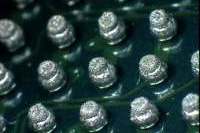
|
|
|
Figure 1: Traditional Flat or Formed Metal Mini-Stencil.
|
No matter how much we attempt to streamline and automate the process, BGA Rework has been, and will likely always be, a mixture of art and science.
The need for a predictable, repeatable process, with its attendant time and cost savings, drives us continually to attempt to remove as much "art" as possible from the BGA rework process as new tools and knowledge become available.
This is preferable to having the success of a rework operation dependent upon the uniquely developed skills of an individual operator. Rework processes typically begin with logical and even obvious solutions; and then they slowly evolve, driven by the continuous need to improve quality and cost efficiency.
The process of preparing a BGA component, or BGA location, for rework is a perfect example of how such improvements may evolve. A key step in the BGA rework process is the application of solder paste at a specific individual location, at either the component footprint on the circuit board or on the component itself.
For some time now, the means of achieving this has been to mimic, in a simple way, the primary circuit board stenciling process through the use of a miniature metal stencil.
This method, however, is time-consuming and awkward, utilizing a taped-to-the-board flat metal mini-stencil or a formed version sometimes held in place with a positioning arm. (See Figure 1)
This stop-gap method simply cannot consistently produce the same result as a stencil printing machine with its controlled automated squeegee functions, stencil lift-off, and optical alignment mechanisms.

|
|
|
Figure 2: New Flexible, Self-Sticking, Polymer Mini-Stencil.
|
With our six BGA rework systems, we do as much BGA rework volume as just about anyone, and then some. The metal mini-stencils that we use to apply solder paste for BGA rework continue to challenge us with inconsistent print volume, stencil flatness issues, site access, and stencil cleaning.
We work hard to make these mini-stencils work properly, and the results often depend on the artistic skills of the operator. Nevertheless, we often must accept less than perfect print quality in the name of efficiency.
The current proliferation of metal mini-stencils ensures that they will be around for some time to come, despite their shortcomings. Two other developments in solder paste stenciling for BGA rework are viable alternatives that may offer significant yield improvements for those willing to apply and master them.
The first of these two alternative processes involves stenciling solder paste directly onto the balls of the BGA component itself. (See Figure 3) This is accomplished by attaching the component to a stencil plate, essentially a thick stencil with a mechanism for keeping the component balls pressed into the apertures of the plate.
Following the attachment of the component to the plate, a squeegee is used to apply solder paste to the plate's opposite surface. The plate is then inverted, component side up, and placed in a nest on the rework machine that has been tooled to accept the stencil plate.
The component is un-clamped from the plate, allowing the pick-up nozzle to access the component and extract it from the stencil plate with the solder paste attached to the component balls. The print quality is inspected through the split image optics of the rework machine prior to placement on the circuit board surface. Heating and reflow follow.

|
|
|
Figure 3: Print-on-Component Image.
|
Another development replaces the rigid metal mini-stencil with a flexible, polymer film stencil with a self-sticking adhesive backing. (See Figure 2)
Unlike the mini-metal stencils, these polymer stencils are flexible and will conform to irregularities in the circuit board surface. Their most interesting feature is their adhesive backing, which seals around BGA pads to ensure that solder paste will not bleed under the stencil when the paste is applied.
Their fold-up side tabs used to locate and place the stencil also serve as solder dams, preventing solder paste spillage onto the circuit board surface.
The following table, derived from our collective BGA rework experience, is a comparative summary of the three BGA rework stenciling technologies discussed above.
BGA Rework Stencil Comparison Table
| |
Traditional Flat or Formed Metal Mini-Stencil |
New Flexible, Self-Sticking, Polymer Mini-Stencil |
New Print-on-Component Stencil Plate |
| Stencil Cost |
Moderate |
Low |
Moderate/High |
| Equipment Impact |
None |
None |
Rework equipment upgrade required to add component pick-up nest. |
| Operator Skill Level Requirement |
High |
Low |
Moderate |
| Volume Consistency of Paste Deposition |
Fair - Dependent on stencil/circuit board flatness and operator squeegee skills. |
Good - Flexible polymer with adhesive sealed apertures ensures consistent volume. |
Good - Dependent on planarity of component balls and precise extraction from plate. |
| Circuit Board and/or Device Planarity Requirements |
Circuit board and stencil must be very flat. |
Non-dependent on circuit board or component flatness. |
Component planarity may impact quality of print. |
| Print Registration Accuracy |
Fair Stencil must be carefully taped to circuit board surface. |
Excellent |
Excellent |
| Risk of Component Damage |
None |
None |
Care must be take in handling components during insertion and clamping onto plate. |
| Component Site Access |
Fair |
Good |
Excellent - No component perimeter clearance required. |
| Post Print/Pre-Placement Inspection |
Excellent |
Excellent |
Fair - Typically depends on quality of split optics viewing of rework machine in use. |
| Stencil Maintenance & Cleaning Requirements |
Moderate - Flatness must be maintained and apertures well cleaned between uses. |
None - Stencils are disposable after single or multi-use. |
Moderate - Deep apertures in stencil plate require careful cleaning between uses. |
Several members of the Circuit Technology Center team contributed to this feature story.
|